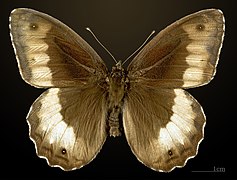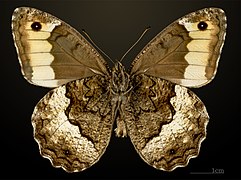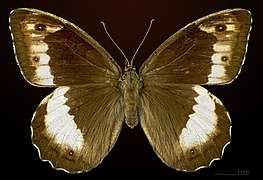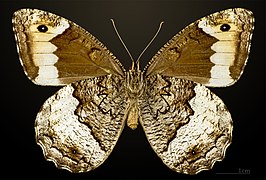Great forest porter
| Great forest porter | ||||||||||||
|---|---|---|---|---|---|---|---|---|---|---|---|---|
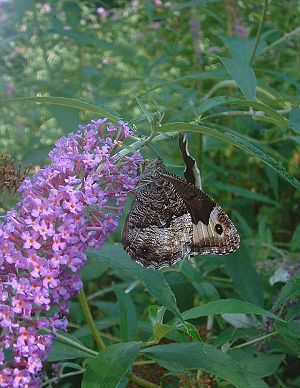
Large forest porter ( Hipparchia fagi ) on a flowering butterfly bush ("Buddleia") |
||||||||||||
| Systematics | ||||||||||||
|
||||||||||||
| Scientific name | ||||||||||||
| Hipparchia fagi | ||||||||||||
| ( Scopoli , 1763) |
The Great Grayling ( Hipparchia fagi ) is a butterfly ( butterfly ) from the family of Julia Butterfly (Satyridae).
features
The moths reach a fore wing length of up to 40 millimeters and are therefore larger than average. However, the females appear larger than the males. The dark wings have a light band in which one or two eye spots can be seen. The underside is more contrasting. In the females, the color now and then turns a little yellow. The colors serve as camouflage: when these butterflies sit on a tree trunk with folded wings, they can hardly be made out. Like many other forest-dwelling species, the butterfly is very shy.
Similar species
The large forest porter can only be distinguished from the small forest porter by examining the Jullien's organs (rod scales): In H. fagi one finds individual, in H. hermione numerous "bristles".
- Small forest porter Hipparchia hermione (Linnaeus, 1764), syn. Hipparchia alcyone (Denis & Schiffermüller, 1775)
- White forest porter Aulocera circe
- Hipparchia syriaca (Staudinger, 1871)
- Hipparchia genava (Frühstorfer, 1908)
Synonyms
The species is listed as Satyrus hermione in older literature. In the latest literature, the very similar Hipparchia alcyone is referred to as Hipparchia hermione .
- Hipparchia hermione Linnaeus, 1764. A summary of the very confused taxonomy can be found in the Lepiforum.
Flight time
The large forest porter flies in one generation from the beginning of June to mid-September, depending on the geographical location.
habitat
The Great Forest Porter can be found in clearings in warm deciduous forests and on the edges of dry meadows up to a height of 1,000 meters. In Germany the species is partially threatened with extinction:
- Red list FRG: 2 (endangered)
Way of life
The caterpillar forage plants include grasses such as the upright bromus ( Bromus erectus ). The nocturnal caterpillars overwinter in the litter. There they create a small hollow for themselves with shaking movements. They are brightly colored and have fine stripes that make them almost invisible.
distribution
The large forest porter is common in northern Spain, Aragon and Catalonia , among others . It can also be found in central, southern and eastern France and sporadically in central France. Its distribution area continues to extend over southwest Germany (Kaiserstuhl), southern Poland , Italy with Sicily , the Balkans and Greece including Lefkada and Corfu . The species is not represented in northern Germany, in the European part of Turkey and almost all Mediterranean islands. The moths can be found vertically from 50 to 1800 meters in height, but mostly they are found in locations below 1000 meters.
swell
Individual evidence
- ↑ Butterfly. 2. Special part: Satyridae, Libytheidae, Lycaenidae, Hesperiidae . In: Günter Ebert, Erwin Rennwald (eds.): The butterflies of Baden-Württemberg . 1st edition. tape 2 . Ulmer, Stuttgart (Hohenheim) 1991, ISBN 3-8001-3459-4 .
- ↑ Hans-Josef Weidemann: Butterfly: observe, determine . Naturbuch-Verlag, Augsburg 1995, ISBN 3-89440-115-X .
- ↑ Kleiner Waldportier, Notes on Taxonomy / Nomenclature
- ↑ Federal Agency for Nature Conservation (Ed.): Red List of Endangered Animals in Germany . Landwirtschaftsverlag, Münster 1998, ISBN 3-89624-110-9 .
- ↑ Tom Tolman, Richard Lewington: The butterflies of Europe and Northwest Africa . Franckh-Kosmos, Stuttgart 1998, ISBN 3-440-07573-7 .
literature
- Manfred Koch , Wolfgang Heinicke: We identify butterflies. 3. Edition. Neumann, Radebeul 1991, ISBN 3-7402-0092-8 .
Web links
- Lepiforum e. V. Taxonomy and Photos
- www.schmetterling-raupe.de
- Moths and Butterflies of Europe and North Africa (English)
- Hipparchia (Hipparchia) fagi at Fauna Europaea
- Hipparchia fagi inthe IUCN 2013 Red List of Threatened Species . Posted by: van Swaay, C., Wynhoff, I., Verovnik, R., Wiemers, M., López Munguira, M., Maes, D., Sasic, M., Verstrael, T., Warren, M. & Settele, J., 2009. Retrieved February 18, 2014.
